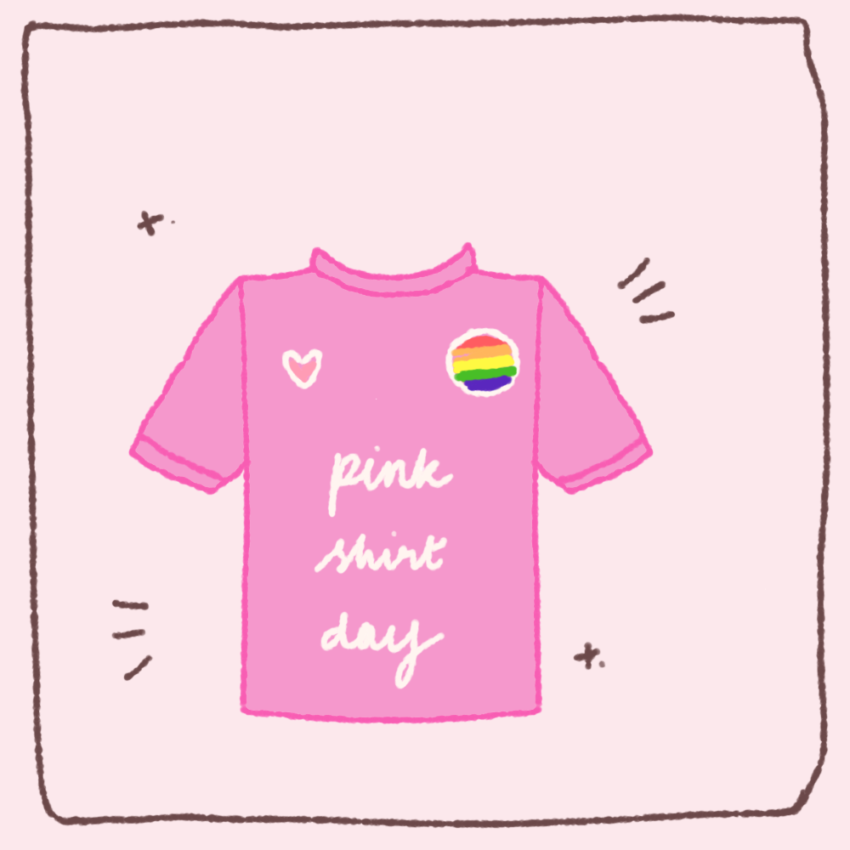This Feb. 22, let’s put on a pink t-shirt and talk about homophobic and gender-based bullying
Content and trigger warning: this article discusses depression, homophobia and suicide

Pink Shirt Day, also known as Anti-Bullying Day, is a day Canadian students may be familiar with — either through a presentation in schools where they got all the kids to chant “No. More. Bullying!” or through the school’s Spirit Day of wearing a pink shirt on the last Wednesday of February.
The origins of Pink Shirt Day can be traced back to 2007 in a small town in Nova Scotia — a teen boy was being bullied for wearing a pink shirt, and a group of friends noticed and decided to stand against the bullying. The next morning, that same group of friends brought hundreds of pink t-shirts to school in a plastic bag and handed them out to their peers. It was said that the boy’s bullies were never heard from again.
However, there is more to the story than just bullying. The entire experience revolves around homophobia. What I was never told when I was younger is that the boy was bullied for wearing pink because he was thought to be gay. Given that pink is often considered a “girl’s colour”, thus making it traditionally feminine, any boy participating in anything traditionally feminine is perceived as gay. He was bullied because he challenged traditional gender norms around masculinity. By not performing his gender “correctly,” he was punished by his peers. Failing to talk about the homophobic bullying is a disservice and incredibly harmful to 2SLGBTQIA+ youth who continue to face similar experiences today.
I only began to connect the bullying with homophobia when I got older and became involved with local 2SLGBTQIA+ organizations like OUTSaskatoon. There, I was finally exposed to queer education, which included learning about the obscure origins of Pink Shirt Day. All through my elementary and high school years, the homophobic and gender-based bullying surrounding Pink Shirt Day was never taught to me despite it being such a large event that was celebrated every single year.
In a 2021 survey conducted by Mental Health America (MHA), nine out of ten 2SLGBTQIA+ students reported being harassed and bullied within the year prior. Over half of all the students reported hearing homophobic remarks often at school and more than 30 per cent reported missing at least a day of school in the past month out of fear for their personal safety. 60 per cent of the students did not report incidents to school staff. One-third who reported an incident said the staff did nothing in response.
Additionally, in a 2011 study conducted by the Centre for Disease Control and Prevention (CDC) on morbidity and mortality in adolescents, it was shown that 2SLGBTQIA+ youth are four times more likely to attempt suicide than their cishet peers, and six times more likely to report high levels of depression compared to peers from families that reported no or low levels of family rejection.
Personally, these statistics do not surprise me in the slightest, but they are devastating to read, especially as a queer and genderqueer person myself. Schools have the responsibility to educate both students and teachers on topics that could potentially save the lives of students. This begins with starting conversations in the classroom, then having students bring those conversations home, then to friends and peers in order to spread awareness, educate, and most importantly, create a welcoming environment for queer youth.
What you can do is begin by asking simple questions about Pink Shirt Day: what is it and why do you think the boy was bullied? Questions around traditional gender roles and the 2SLGBTQIA+ community can look like: what are gender norms? How does that impact how people express themselves? What is toxic masculinity? What does it mean to be part of the 2SLGBTQIA+ community? How can you be an ally to the 2SLGBTQIA+ community? How does privilege impact how people are treated?
Many youth today are still bullied because of their sexuality, gender identity and gender expression. If we do not acknowledge that Pink Shirt Day is about homophobic and gender-based bullying, then we will not make progress towards creating an inclusive space for all identities. So, later this month on Feb. 22, put on a pink t-shirt and be brave enough to start a conversation that matters.